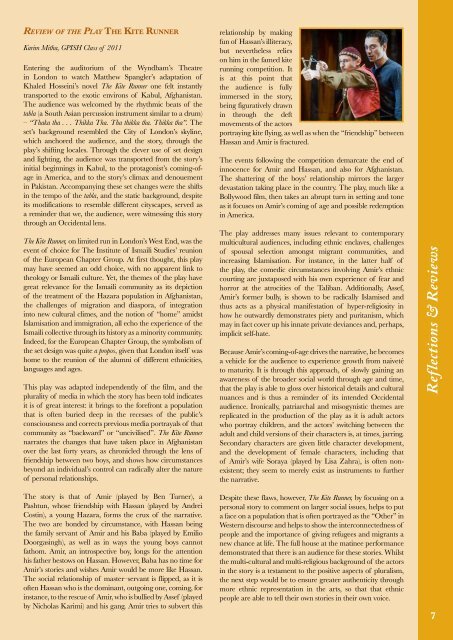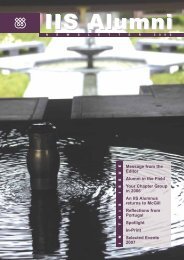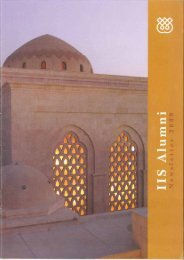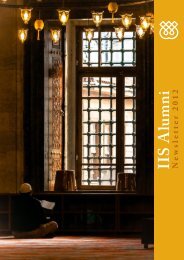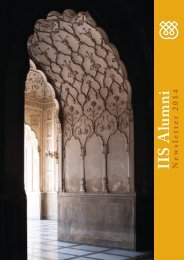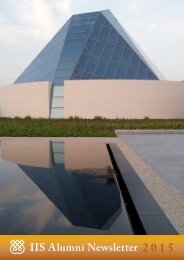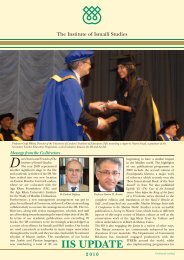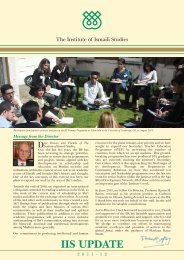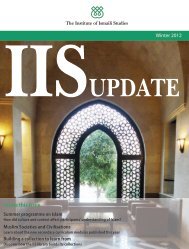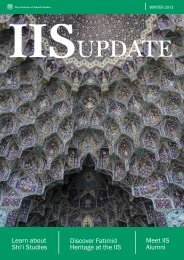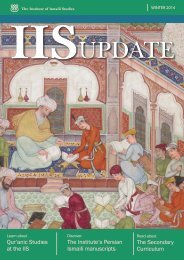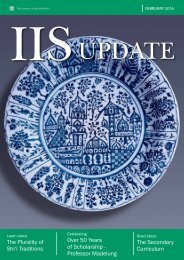IIS Alumni Booklet 2016
Create successful ePaper yourself
Turn your PDF publications into a flip-book with our unique Google optimized e-Paper software.
Review of the Play The Kite Runner<br />
Karim Mitha, GPISH Class of 2011<br />
Entering the auditorium of the Wyndham’s Theatre<br />
in London to watch Matthew Spangler’s adaptation of<br />
Khaled Hosseini’s novel The Kite Runner one felt instantly<br />
transported to the exotic environs of Kabul, Afghanistan.<br />
The audience was welcomed by the rhythmic beats of the<br />
tabla (a South Asian percussion instrument similar to a drum)<br />
– “Thaka tha . . . Thikka Tha. Tha thikka tha. Thikka tha”. The<br />
set’s background resembled the City of London’s skyline,<br />
which anchored the audience, and the story, through the<br />
play’s shifting locales. Through the clever use of set design<br />
and lighting, the audience was transported from the story’s<br />
initial beginnings in Kabul, to the protagonist’s coming-ofage<br />
in America, and to the story’s climax and denouement<br />
in Pakistan. Accompanying these set changes were the shifts<br />
in the tempo of the tabla, and the static background, despite<br />
its modifications to resemble different cityscapes, served as<br />
a reminder that we, the audience, were witnessing this story<br />
through an Occidental lens.<br />
The Kite Runner, on limited run in London’s West End, was the<br />
event of choice for The Institute of Ismaili Studies’ reunion<br />
of the European Chapter Group. At first thought, this play<br />
may have seemed an odd choice, with no apparent link to<br />
theology or Ismaili culture. Yet, the themes of the play have<br />
great relevance for the Ismaili community as its depiction<br />
of the treatment of the Hazara population in Afghanistan,<br />
the challenges of migration and diaspora, of integration<br />
into new cultural climes, and the notion of “home” amidst<br />
Islamisation and immigration, all echo the experience of the<br />
Ismaili collective through its history as a minority community.<br />
Indeed, for the European Chapter Group, the symbolism of<br />
the set design was quite a propos, given that London itself was<br />
home to the reunion of the alumni of different ethnicities,<br />
languages and ages.<br />
This play was adapted independently of the film, and the<br />
plurality of media in which the story has been told indicates<br />
it is of great interest: it brings to the forefront a population<br />
that is often buried deep in the recesses of the public’s<br />
consciousness and corrects previous media portrayals of that<br />
community as “backward” or “uncivilised”. The Kite Runner<br />
narrates the changes that have taken place in Afghanistan<br />
over the last forty years, as chronicled through the lens of<br />
friendship between two boys, and shows how circumstances<br />
beyond an individual’s control can radically alter the nature<br />
of personal relationships.<br />
The story is that of Amir (played by Ben Turner), a<br />
Pashtun, whose friendship with Hassan (played by Andrei<br />
Costin), a young Hazara, forms the crux of the narrative.<br />
The two are bonded by circumstance, with Hassan being<br />
the family servant of Amir and his Baba (played by Emilio<br />
Doorgasingh), as well as in ways the young boys cannot<br />
fathom. Amir, an introspective boy, longs for the attention<br />
his father bestows on Hassan. However, Baba has no time for<br />
Amir’s stories and wishes Amir would be more like Hassan.<br />
The social relationship of master–servant is flipped, as it is<br />
often Hassan who is the dominant, outgoing one, coming, for<br />
instance, to the rescue of Amir, who is bullied by Assef (played<br />
by Nicholas Karimi) and his gang. Amir tries to subvert this<br />
relationship by making<br />
fun of Hassan’s illiteracy,<br />
but nevertheless relies<br />
on him in the famed kite<br />
running competition. It<br />
is at this point that<br />
the audience is fully<br />
immersed in the story,<br />
being figuratively drawn<br />
in through the deft<br />
movements of the actors<br />
portraying kite flying, as well as when the “friendship” between<br />
Hassan and Amir is fractured.<br />
The events following the competition demarcate the end of<br />
innocence for Amir and Hassan, and also for Afghanistan.<br />
The shattering of the boys’ relationship mirrors the larger<br />
devastation taking place in the country. The play, much like a<br />
Bollywood film, then takes an abrupt turn in setting and tone<br />
as it focuses on Amir’s coming of age and possible redemption<br />
in America.<br />
The play addresses many issues relevant to contemporary<br />
multicultural audiences, including ethnic enclaves, challenges<br />
of spousal selection amongst migrant communities, and<br />
increasing Islamisation. For instance, in the latter half of<br />
the play, the comedic circumstances involving Amir’s ethnic<br />
courting are juxtaposed with his own experience of fear and<br />
horror at the atrocities of the Taliban. Additionally, Assef,<br />
Amir’s former bully, is shown to be radically Islamised and<br />
thus acts as a physical manifestation of hyper-religiosity in<br />
how he outwardly demonstrates piety and puritanism, which<br />
may in fact cover up his innate private deviances and, perhaps,<br />
implicit self-hate.<br />
Because Amir’s coming-of-age drives the narrative, he becomes<br />
a vehicle for the audience to experience growth from naiveté<br />
to maturity. It is through this approach, of slowly gaining an<br />
awareness of the broader social world through age and time,<br />
that the play is able to gloss over historical details and cultural<br />
nuances and is thus a reminder of its intended Occidental<br />
audience. Ironically, patriarchal and misogynistic themes are<br />
replicated in the production of the play as it is adult actors<br />
who portray children, and the actors’ switching between the<br />
adult and child versions of their characters is, at times, jarring.<br />
Secondary characters are given little character development,<br />
and the development of female characters, including that<br />
of Amir’s wife Soraya (played by Lisa Zahra), is often nonexistent;<br />
they seem to merely exist as instruments to further<br />
the narrative.<br />
Despite these flaws, however, The Kite Runner, by focusing on a<br />
personal story to comment on larger social issues, helps to put<br />
a face on a population that is often portrayed as the “Other” in<br />
Western discourse and helps to show the interconnectedness of<br />
people and the importance of giving refugees and migrants a<br />
new chance at life. The full house at the matinee performance<br />
demonstrated that there is an audience for these stories. Whilst<br />
the multi-cultural and multi-religious background of the actors<br />
in the story is a testament to the positive aspects of pluralism,<br />
the next step would be to ensure greater authenticity through<br />
more ethnic representation in the arts, so that that ethnic<br />
people are able to tell their own stories in their own voice.<br />
Reflections & Reviews<br />
7


